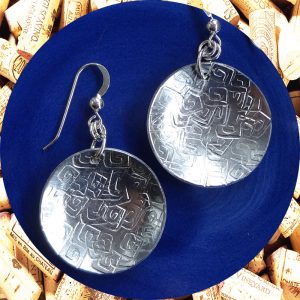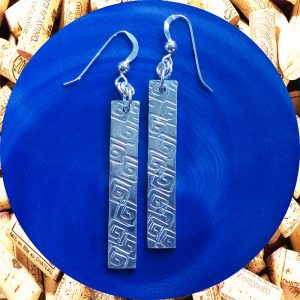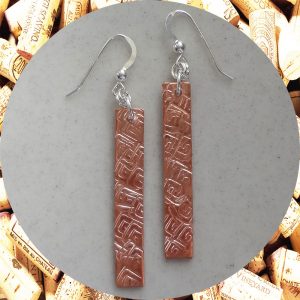Jazzy Notes Wire Earrings – Sterling Silver Plated
$16.00
Silver Plated Handcrafted Jazzy Notes Wire Earrings. These freeform wire funky pair are perfect for your favorite musician. Each pair is furnished with Sterling Silver hooks
Description
- Jazzy Notes Wire Earrings are approximately 20 mms by 35 mms and are created with silver-plated copper wire. Also available in Sterling Silver.
- Each piece is one hundred percent unique as each is individually handcrafted.
- An extremely lightweight and durable piece of wearable art.
- The definition of a treble clef is a symbol that is placed on every line of music to show the notes which will be sung or played by voices and instruments that can achieve higher notes. The Treble Clef is the upper stave of the grand stave used for harp and keyboard instruments. It is also sometimes used, along with the tenor clef, for the highest notes played by bass-clef instruments such as the cello, double bass (which sounds an octave lower), bassoon, and trombone.
- An eighth note, also called a quaver, is a note played for one eighth the duration of a whole note (semibreve). It lasts a quarter of the duration of a half note (minim) and half of the duration of a quarter note (crotchet). In 4/4 time a whole note lasts for four beats. An 8th note lasts for half a beat. These beauties should give you years and years of loving wear.
- These notes are adorned with Japanese Miracle beads. Miracle Beads are made with a lucite acrylic core with a silverplated finish. This core is coated with several layers of translucent, colorful lacquer, which viewed in the light, creates a miraculous glow. It is as if there is a bead within a bead. Although many copies of these beads are manufactured in Taiwan and China, the highest quality of Miracle beads come from Japan, which is what we use.
- The ear wire is a sterling silver flat fishhook (shepherd hook) with an open loop.
- Kimi Designs also offers a pair of plastic backs with each pair of Jazzy Notes Wire Earrings.
Discovery of Silver by Dr. Doug Stewart
- Silver has been in use since prehistoric times. We do not know who discovered it, although the discovery would almost certainly have been of native silver.
- Nuggets of native silver metal can be found in minerals and sometimes in rivers, but they are rare. Despite native silver’s rarity, very large pieces of it have been found, such as those found in the early 1900s in Northern Ontario, Canada described as “pieces of native silver as big as stove lids and cannonballs.”
- Silver has a special place in the history of the elements because it is one of the first five metals discovered and used by humans. The others were gold, copper, lead, and iron.
- Silver objects dating from before 4000 BC have been found in Greece and from slightly later in Anatolia (in modern Turkey). Silver artifacts have been found in the Sumerian city of Kish dating from about 3000 BC.
- Silver and lead often appear together in nature, for example in the mineral galena which is mainly lead sulfide. Galena actually looks metallic (see image) and would have caught the eyes of people looking for metals.
- The silver objects found in Greece, Turkey, and Kish were made of silver that was refined from lead-containing ores such as galena. (Humans have been successful chemists for a surprisingly long time.)
- First, the ore was smelted under reducing conditions to obtain a mixture of silver and lead. The metals then went through cupellation: the metals were heated to about 1000 oC in a strong stream of air. Under these conditions lead reacts with oxygen forming lead oxide, leaving liquid silver metal floating on top. (3), (4)
- Our name for the element is derived from the Anglo-Saxon for silver, ‘seolfor,’ which itself comes from ancient Germanic ‘silabar.’
- Silver’s chemical symbol, Ag, is an abbreviation of the Latin word for silver, ‘argentum.’ The Latin word originates from argunas, a Sanskrit word meaning shining.
- The historical association between silver and money is still found in some languages. The French word for silver is argent, and the same word is used for money. The Romans used the word ‘argentarius’ to mean banker (silver trader).
Silver Element Data Zone
- Classification: Silver is a transition metal
- Color: silver
- Atomic weight: 107.868
- State: solid
- Melting point: 961.95 oC, 1235.1 K
- Boiling point: 2155 oC, 2428 K
- Electrons: 47
- Protons: 47
- Neutrons in most abundant isotope: 60
- Electron shells: 2,8,18,18,1
- Electron configuration: [Kr] 4d10 5s1
- Density @ 20oC: 10.5 g/cm3





